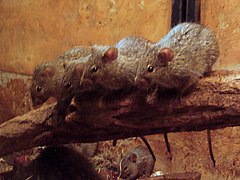Kusu (myszy)
| Arvicanthis[1] | |||
| Lesson, 1842[2] | |||
 Przedstawiciel rodzaju – kusu nilowy (A. niloticus) | |||
| Systematyka | |||
| Domena | |||
|---|---|---|---|
| Królestwo | |||
| Typ | |||
| Podtyp | |||
| Gromada | |||
| Podgromada | |||
| Infragromada | |||
| Rząd | |||
| Podrząd | |||
| Infrarząd | |||
| Nadrodzina | |||
| Rodzina | |||
| Podrodzina | |||
| Plemię | Arvicanthini | ||
| Rodzaj | kusu | ||
| Typ nomenklatoryczny | |||
Lemmus niloticus É. Geoffroy Saint-Hilaire, 1803 | |||
| Synonimy | |||
| Gatunki | |||
| |||
Kusu[4] (Arvicanthis) – rodzaj ssaka z podrodziny myszy (Murinae) w rodzinie myszowatych (Muridae).
Zasięg występowania
Rodzaj obejmuje gatunki występujące w Afryce[5][6][7].
Morfologia
Długość ciała (bez ogona) 115–188 mm, długość ogona 88–159 mm, długość ucha 13–24 mm, długość tylnej stopy 22–38 mm; masa ciała 48–180 g[6].
Systematyka
Etymologia
- Arvicanthis: rodzaj Arvicola Lacépède, 1799 (karczownik); łac. acanthis „kręgosłup”[8].
- Isomys: gr. ισος isos „jednakowy, podobny”; μυς mus, μυος muos „mysz”[9]. Gatunek typowy: Mus variegatus Lichtenstein, 1823 (Lemmus niloticus É. Geoffroy Saint-Hilaire, 1803).
Podział systematyczny
Do rodzaju należą następujące żyjące współcześnie gatunki[5][4]:
- Arvicanthis rufinus (Temminck, 1853) – kusu gwinejski
- Arvicanthis ansorgei O. Thomas, 1910 – kusu sahelski
- Arvicanthis neumanni (Matschie, 1894) – kusu somalijski
- Arvicanthis nairobae J.A. Allen, 1909 – kusu sawannowy
- Arvicanthis abyssinicus (Rüppell, 1842) – kusu abisyński
- Arvicanthis blicki Frick, 1914 – kusu halny
- Arvicanthis niloticus (É. Geoffroy Saint-Hilaire, 1803) – kusu nilowy
oraz gatunek wymarły[10]:
- Arvicanthis broekhuisi Hordijk & Bruijn, 2009 – wymarły gatunek, żyjący na przełomie miocenu i pliocenu na obszarze dzisiejszej Grecji
Przypisy
- ↑ Arvicanthis, [w:] Integrated Taxonomic Information System [online] (ang.).
- ↑ R.-P. Lesson: Nouveau tableau du règne animal: Mammifères. Paris: Arthus Bertrand, 1842, s. 147. (fr.).
- ↑ C.J. Sundevall. Om Professor J. Hedenborgs insaimlingar af Däggdjur i Nordöstra Africa och Arabien. „Kungl. Svenska Vetenskapsakademiens Handlingar”. 31, s. 219, 1842. (łac. • szw.).
- ↑ a b Nazwy polskie za: W. Cichocki, A. Ważna, J. Cichocki, E. Rajska-Jurgiel, A. Jasiński & W. Bogdanowicz: Polskie nazewnictwo ssaków świata. Warszawa: Muzeum i Instytut Zoologii PAN, 2015, s. 264. ISBN 978-83-88147-15-9. (pol. • ang.).
- ↑ a b C.J. Burgin, D.E. Wilson, R.A. Mittermeier, A.B. Rylands, T.E. Lacher & W. Sechrest: Illustrated Checklist of the Mammals of the World. Cz. 1: Monotremata to Rodentia. Barcelona: Lynx Edicions, 2020, s. 524. ISBN 978-84-16728-34-3. (ang.).
- ↑ a b Ch. Denys, P. Taylor & K. Aplin. Opisy gatunków Muridae: Ch. Denys, P. Taylor, C. Burgin, K. Aplin, P.-H. Fabre, R. Haslauer, J. Woinarski, B. Breed & J. Menzies: Family Muridae (True Mice and Rats, Gerbils and relatives). W: D.E. Wilson, R.A. Mittermeier & T.E. Lacher (red. red.): Handbook of the Mammals of the World. Cz. 7: Rodents II. Barcelona: Lynx Edicions, 2017, s. 752–753. ISBN 978-84-16728-04-6. (ang.).
- ↑ D.E. Wilson & D.M. Reeder (red. red.): Genus Arvicanthis. [w:] Mammal Species of the World. A Taxonomic and Geographic Reference (Wyd. 3) [on-line]. Johns Hopkins University Press, 2005. [dostęp 2020-12-13].
- ↑ Palmer 1904 ↓, s. 123.
- ↑ Palmer 1904 ↓, s. 353.
- ↑ Kees Hordijk i Hans de Bruijn. The succession of rodent faunas from the Mio/Pliocene lacustrine deposits of the Florina-Ptolemais-Servia Basin (Greece). „Hellenic Journal of Geosciences”. 44, s. 21–103, 2009. (ang.).
Bibliografia
- T.S. Palmer. Index Generum Mammalium: a List of the Genera and Families of Mammals. „North American Fauna”. 23, s. 1–984, 1904. (ang.).
Media użyte na tej stronie
Autor: (of code) -xfi-, Licencja: CC BY-SA 3.0
The Wikispecies logo created by Zephram Stark based on a concept design by Jeremykemp.

